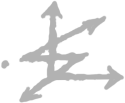The Ten of Swords
Most books on Tarot begin with The Fool. That makes sense. The Major Arcana are the most exciting cards, and The Fool is a card about beginnings that's labeled as "card zero." It's an obvious starting place.
With that said, I think I've probably read or listened to thirty or forty different takes on The Fool at this point, and I'm not sure I've heard half as many about, say, the Eight of Cups. I think it's important to devote time to learning every card, and more than that, to devote time to seeing their connections. The way they're often presented -- one suit at a time, from Ace to King in numerical order -- presents one view of the cards, but it leaves a lot unsaid.
So here's my approach -- each update is a new card, one connected in some way with the previous one. I'm starting with the Ten of Swords for a few reasons. First, I think it's a great example of the way I read and understand a card. It's a process that really feels like reading to me, not like recitation of something memorized in advance. Second, this card has a bit of a reputation.
When I first learned to read Tarot, I learned what each card meant using a set of flash cards I downloaded from some long-forgotten website not unlike this one. Its description of the Ten of Swords was very memorable: "Ruin. The worst card in the pack."
I'm not sure that's entirely wrong. The Ten of Swords does depict someone lying face down on a barren landscape -- I always see it as a battlefield, but there's not much on the card to actually support that. There are dark clouds overhead. They've been stabbed by the aforementioned ten swords, and it's hard to tell fabric from blood. It is certainly not a happy card.
But I think that's where most analyses end. It's a very sad, very bad card, and it means things are going very poorly. I think there's more going on here. Yes, dark clouds and blood and ten swords in your back all point to something very bad, but there's other information that doesn't fit so neatly.
Let's think about the name, for example. The Ten of Swords. The tens are usually about abundance and excess. Pentacles tend to be about material circumstances, so the Ten of Pentacles shows a whole bunch of coins. Most people read it as something like "great news, a whole bunch of coins." Cups tend to be about relationships, creativity, and emotion, and the Ten of Cups shows a scene of intense happiness and celebration. I've heard it called the "happily ever after" card.
But swords are usually about intellect, wits, facts, and conscious thought. How does the Ten of Swords represent an abundance of any of those?
This person has been stabbed in the back -- hit by something they never saw coming. They couldn't have stayed standing for all of it. Certainly, some of these sword hit when they were already on the ground, face down, unable to see. To me, that's the crux of this card. It's a moment of horrible comprehension. An understanding of your situation that can only come through pain.
Look closely at the ten swords. Many decks depict all ten stabbing the person, but the Waite-Smith deck doesn't. The tenth sword missed. The person's head -- or more poetically, their mind -- is unharmed. In fact, the person is turned away from us, which means they're turned toward that sword. They can finally see this one. Again, horrible, painful understanding.
Another strange detail on this card: look at the person's hand. To me, that certainly looks like the gesture used by Catholic Popes, sometimes called the Hand of Benediction. That gesture appears elsewhere in the Tarot: unsurprisingly, The Hierophant use the same gesture. This is the next card we'll talk about -- I think these two are very closely linked.
If you Google "Hand of Benediction," you'll get a Wikipedia article on nerve damage. Nerve damage can make it difficult or impossible to fully extend those fingers, and many people speculate that this may be the origin of the gesture in Catholicism -- Saint Peter had nerve damage, and later Popes emulated his gesture.
In this moment, as their body is destroyed, the figure on the Ten of Swords becomes a reflection of The Hierophant. They are the keeper of unique knowledge and understanding.
The horizon on this card is the one bright spot. Most decks color it as a stripe of bright yellow, above pale blue mountains and below dark gray clouds. The clouds will clear. This card is not permanent. Things will improve. But if this card come up in a reading, the clear horizon is an afterthought. The primary thing to focus on in the moment is something like "I'm so sorry," or "what happened?". After that, you can think about the future.
